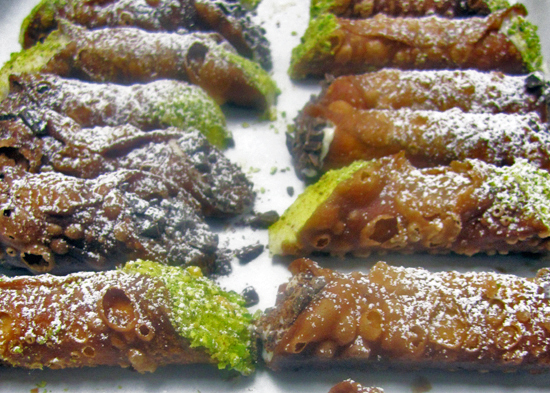Recipe: Cannoli Extravaganza
In the past few weeks, DICED has brought you two cookie recipes and asked to hear your favorite holiday memories. With only a few more sleeps until Santa comes, we asked the ICE Director of Pastry & Baking Arts Program, Andrea Tuntunjian to share her holiday traditions
In my family, holiday baking tradition began with my great-grandmother, her sisters, and their extended families after they came to this country. Small groups of women would spend an entire day or so together preparing one or two kinds of pastries. Afterwards, they would meet up and share their desserts, so each family would have several different pastries for their holiday.

In my maternal family, these pastries included cannoli, crispedella, pizzelle, and casateddideciciri. Baking community-style not only created memories and traditions, but it was also a way to teach and pass on the recipes to the next generation. With each continuous generation, families spread out and got smaller, so many of these traditions were lost. I still hold on to preparing cannoli, as it happens to be my favorite. I have created a small family custom of my own.
Each Christmas season my daughter and I pick a day to take over our home kitchen and prepare about two hundred cannoli. We give dozens away to friends and family and every year we watch the list grow. As you can imagine, people have come to expect them and look forward to their arrival. I certainly hope this tradition withstands the test of time and gets passed down to future generations. We happen to use the same recipe as ICE students. In my experience, nothing can compare to a true Sicilian cannoli. But, I have to say the recipe by Nick Malgieri used in our professional Pastry & Baking Arts curriculum comes extremely close.
Ingredients
Shells
- 13 ounces all-purpose flour
- 1 1/2 ounces sugar
- 1 teaspoon salt
- 1 teaspoon cinnamon
- 1 1/2 ounces butter or lard
- 1 large egg
- 1 large egg yolk
- 4 ounces dry white wine or dry vermouth
- 1 egg white, lightly beaten Oil for frying
Ricotta Filling
- 2 pounds ricotta
- 1/2 pound confectioners’ sugar
- 1 teaspoon vanilla extract
- 1/2 teaspoon cinnamon
- 1 ounce chopped semisweet chocolate
- 1 ounce chopped candied orange peel
- Chopped blanched pistachios for garnish
- Confectioners’ sugar for dusting
Instructions
- To prepare the shells, combine the dry ingredients and then mix in all the liquid ingredients. Knead them together on a lightly floured counter until it is stiff and ropey.
- Divide your dough into 3 or 4 pieces. Make sure to wrap the remaining pieces in plastic to prevent them from drying out. The dough is extremely firm so rolling it properly by hand is near impossible. Use a pasta machine or pasta dough rolling attachment to a stand mixer. Lightly flour the dough and pass it through the widest setting of the pasta machine. In the beginning it may rip in pieces. Press it together, fold it in half, and pass it through the pasta machine again.
- Continue to repeat this process several times until the dough is visibly smooth and seemingly elastic. Wrap the dough in plastic and refrigerate it for at least 1 hour to overnight to allow it to rest. Repeat this process with the remaining pieces of dough. Unwrap one piece of dough and sprinkle it lightly with flour. Press or roll the dough by hand until it is roughly the width of the pasta machine.
- Beginning with the widest setting of the pasta machine, pass the dough through the machine. Reduce the opening setting by two notches, and pass the dough through the machine again. Repeat this process, reducing the setting by two notches each time, until you get to the next to last setting. Flour the dough as necessary to prevent it from sticking. Place the dough on a lightly floured surface and cover it with plastic. Repeat with the remaining pieces of dough. Cut the dough into 4-inch disks using a round cutter. Roll the disks into a slight oval, and place the cannoli tube lengthwise on the oval. Wrap the dough around the tube, (not too tight) and moisten the overlap with egg white to seal. Make sure to not to get any egg white on the cannoli tube, otherwise the dough will stick to the tube and break when you try and remove it.
- When all the dough is rolled begin pre-heating the oil. Place the oil in a large pot. It should be about 4-inches deep. Heat the oil to 375°F. Fry the cannoli until they are a deep golden color and small blisters appear on the surface. When the cannolis are done, remove them from the pan and allow them to drain on paper towel lined pans. While the tubes are still hot, use oven mitts or towels to carefully remove the metal tubes from the shells. Do not wait until the cannolis are cool, or the pastry shell stick to the tube.
- Once the tubes are free and cooled, repeat the process with the remaining dough until all of the pieces have been fried. To prepare the filling, place the ricotta in the bowl of a stand mixer and beat with the paddle attachment briefly to soften. Add the confectioners’ sugar, vanilla and cinnamon, mixing only to combine.
- Remove from the machine and fold in the chocolate and candied fruit. Chill until ready to use. Only fill the cannoli when you are ready to serve them, so they stay crispy and fresh. After the shells are filled, sprinkle the ends with pistachios and lightly dust with confectioners’ sugar.


Add new comment